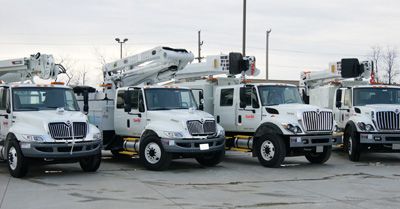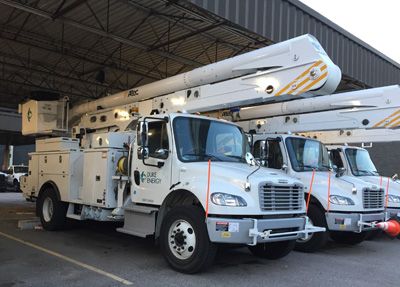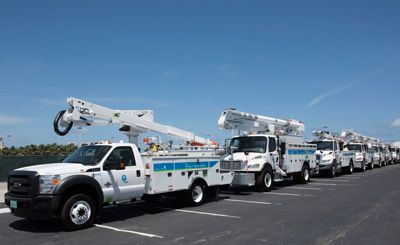The Low-Hanging Fruit for Greening Your Fleet
What if you could convert the majority of your fleet to run on a cleaner-burning, renewable fuel with minimal capital investment. Would you do it?
According to NTEA’s 2019 Fleet Purchasing Outlook, a growing number of fleet professionals are saying they would, with survey participants naming biodiesel as their top alternative fuel choice – and their top choice for future interest.
Think of biodiesel as the low-hanging fruit for fleets to make a significant dent in their green initiatives without breaking the bank. That’s because the fuel is relatively easy to get, and biodiesel blends up to B20 (20% biodiesel and 80% petrodiesel) can be used in most diesel engines without modification. Compared to petrodiesel, B20 reduces carbon emissions by 16% on average, according to the National Biodiesel Board. And you can use biodiesel in conjunction with your fleet electrification efforts, such as with hybrid-electric diesel trucks.
One fleet that has gone all-in with biodiesel is Chicago-based Commonwealth Edison Co., which began using the fuel in 2001. In February, ComEd was recognized by the Chicago Area Clean Cities Coalition for their extensive biodiesel use by receiving two Green Fleet Leadership Awards – the first for reducing their greenhouse gas emissions by nearly 5,000 tons in 2017 with biodiesel and electric vehicles, and the second award for reducing nearly 370,000 gasoline-gallon equivalents of fuel by using biodiesel.
What has ComEd’s experience been with biodiesel? What lessons have they learned? And what advice do they have for other utility fleet professionals who are considering making the transition?
UFP recently spoke with Les Faul, fleet operations manager at ComEd, to get his perspective.
UFP: What blend of biodiesel does ComEd primarily use?
Les Faul: It depends on the time of the year. When we first started our biodiesel program, we were running B20 year-round. But as the manufacturers and the tolerances have changed, we have adjusted our blend. We still run B20 throughout the summer months, but in the winter, we have pared back to B11.
One of the common criticisms of using biodiesel is the issue of fuel gelling in the winter. What has ComEd done to mitigate that issue?
Glycerin and moisture in the fuel [which can lead to gelling] don’t seem to have any effect on the fuel in the summer months. The warmth thins out the fuel mixture, allowing it to flow through the engine. But as the diesel gets cold, you’ve got a cloud point where the fuel begins to crystallize – a cold filter plug point, where the diesel will no longer flow through the equipment, including the filters and the fuel system. And that’s where you’ve got the issues with your vehicle.
We monitor both [the glycerin and moisture] levels through testing throughout our winter months to ensure that we’re targeting where our threshold is.
And what we have found works for us is to go with a lower biodiesel blend in the winter – B11 – while also using a Number 1 oil, a dryer diesel [than the standard Number 2 diesel] to minimize moisture.
This winter, Chicago encountered record-cold temperatures. How did the biodiesel hold up?
We consider ourselves first responders, so we want to ensure the highest operability standards for our equipment – that we’re not sitting on the side of the road due to any issues concerning our fuel. We always err on the side of caution.
In the Chicago area this winter, when we had a few consecutive days of nearly -30 [degrees Fahrenheit] actual temperature, our fuel was not a major concern for us. We weren’t running straight Number 1 oil like a lot of the arctic utilities might be; we were still running our biodiesel even during the coldest parts of the year.
What does ComEd’s biodiesel fueling infrastructure look like? How do you go about fueling off-site?
It’s a little bit of a mixed bag. We have on-site fueling at 19 of our 21 sites. All of those locations have our biodiesel blend, whether it’s our summer or winter blend.
Also, because of how we run and operate, especially during storms and in remote areas, our drivers can get fueling at an off-site or public facility. But they are encouraged to use our on-site fuel. That’s because we’ve got much better control over the quality of our fuel than we have at the public fuel stations.
Where do you see ComEd’s use of biodiesel fitting into your overall green fleet strategy? Is it a “bridge fuel” to full electrification? Or does it fit in combination with your fleet electrification initiatives?
Biodiesel is not going to be a bridge. It has been one of our core strategies for quite some time. I would say our biodiesel use will continue in combination with electrification, especially in our fleet. That’s because we don’t have a lot of opportunities to go 100% electric with the duty cycles that we’ve got to run, especially when we’re in storm mode, running 24 hours a day.
But we definitely do have a strategy to increase the electrification of our fleet, especially when it comes to [electric power takeoff] trucks. So, we’re running biodiesel vehicles with electric power takeoff units to run our bucket trucks’ HVAC cab comfort systems. And anywhere that we can go 100% electric, we will.
What advice do you have for other utility fleet professionals about what to consider when transitioning to biodiesel?
If you’re making the transition to biodiesel, especially into the higher biodiesel blends [like B20], make sure you do your prep work. Clean your in-ground storage tanks, have a filter exchange program going at least for the first month as you clean out your vehicle tanks, and then put in place a good change management program with your end users.
In most cases, the end users will never know the difference [between diesel and biodiesel]. But if you don’t engage them at the start, sometimes there can be a negative perception of the biodiesel product. It’s one of those culture changes that if you manage it well, you’ll be fine. Biodiesel is a very reliable product. There will be no performance issues that the driver will ever notice.












